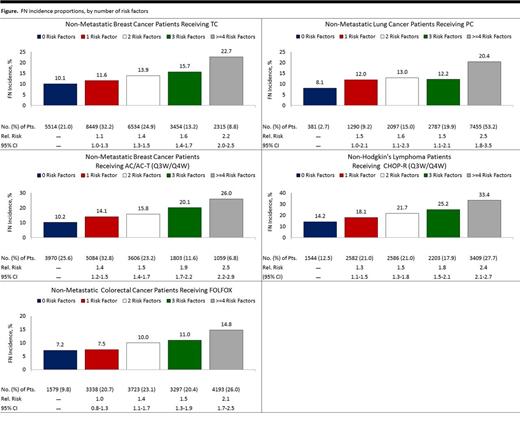Abstract
Background: Clinical practice guidelines recommend primary prophylactic colony-stimulating factor (CSF) when risk of febrile neutropenia (FN) is ≥20%. Evaluating FN risk among patients who receive regimens that are not documented as high risk in guidelines can be challenging, as some patients may be at a high risk based on a combination of the regimen and their risk factors.
Methods: A retrospective cohort design and data from two US private healthcare claims repositories (2003-2012) were employed. The study population comprised cancer patients aged ≥18 years who initiated a course of chemotherapy with a regimen classified as low or intermediate, or that was unclassified, in terms of FN risk based on guidelines for CSF use. For each subject, the first qualifying chemotherapy course, and each cycle and FN episode within the course, was identified; use of CSF prophylaxis also was identified. FN was ascertained using diagnosis codes for neutropenia, fever, and/or infection; for FN requiring outpatient care only, receipt of intravenous antimicrobials also was required. FN incidence proportion was evaluated during the course within cohorts stratified by tumor type and regimen, for all patients in each cohort and by FN risk factor. Risk factorsdocumented in guidelines and the published literature, and listed in the Table hereinwere evaluated during the 12-month pre-chemotherapy period. Unadjusted relative risks of FN for patients with versus without risk factors, and by the number of risk factors (i.e., risk factor stacking), were estimated. Only results for the five most frequently observed tumor/regimen combinations are reported herein.
Results: Among patients with one of the five most frequently observed tumor/regimen combinations (n=84,252), 74-97% had ≥1 risk factor for FN and 42-88% had ≥2 (Table). Among patients with ≥1 risk factor, FN incidence ranged from 11-25% (relative risk vs. those without risk factors, 1.4-2.1), and increased in a graded and monotonic fashion with the number of risk factors present (Figure).
Conclusion: In this retrospective evaluation of nearly 85,000 cancer patients receiving chemotherapy regimens not classified as high-risk for FN in US clinical practice, the large majority had at least one risk factor for FN and many had two or more. FN incidence was found to be markedly elevated in these patients, especially those with multiple risk factors (i.e., risk factor stacking).
Weycker:Amgen: Research Funding. Li:Amgen: Employment, Equity Ownership. Barron:Amgen: Employment, Equity Ownership. Wu:Amgen: Research Funding. Morrow:Amgen: Employment, Equity Ownership. Xu:Amgen: Employment, Equity Ownership. Reiner:Amgen: Employment, Equity Ownership. Garcia:Amgen: Employment, Equity Ownership. Mhatre:Amgen: Employment. Lyman:Amgen: Research Funding.
Author notes
Asterisk with author names denotes non-ASH members.



This feature is available to Subscribers Only
Sign In or Create an Account Close Modal